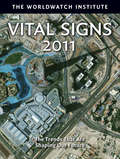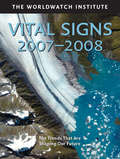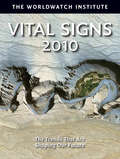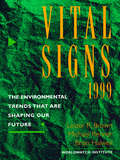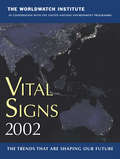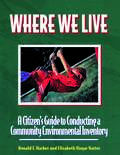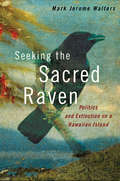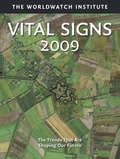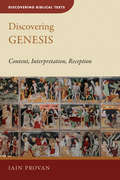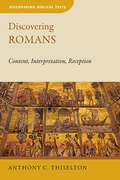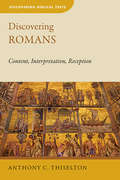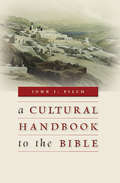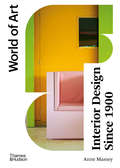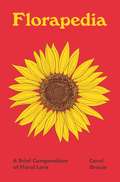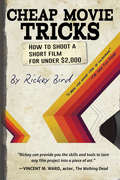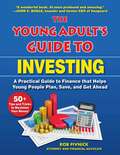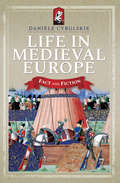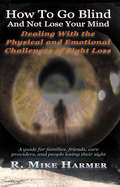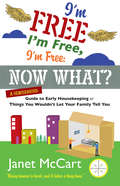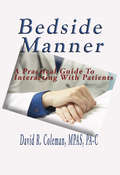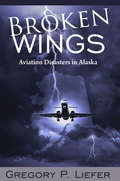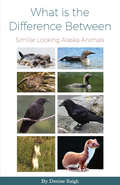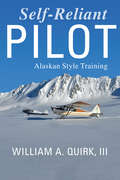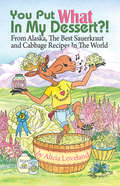- Table View
- List View
Vital Signs 2011 (Vital Signs)
by The Worldwatch InstituteThis eighteenth volume of the Worldwatch Institute series makes it clear that the Great Recession affects many of the world's leading economic, social, and environmental trends - but that the impact can be very different by country.
Vital Signs 2007-2008 (Vital Signs)
by The Worldwatch InstituteThis report tracks and analyzes 44 trends that are shaping our future, and includes graphs and charts to provide a visual comparison over time. Categories of trends include: Food, Agricultural Resources, Energy and Climate, Global Economy, Resource Economics, Environment, Conflict and Peace, Communications and Transportation, Population and Society, and Health and Disease.
Vital Signs 2010 (Vital Signs)
by The Worldwatch InstituteThis seventeenth edition of the Worldwatch Institute series shows that climate change continues to cast a long shadow over the world's leading economic, social, and environmental trends.
Vital Signs 1999 (Vital Signs)
by The Worldwatch InstituteThe global trends documented in Vital Signs 1999--from a decline in nuclear power generating capacity to the proliferation of genetically modified crops--will play a large part in determining the quality of our lives and our children's lives in the next decade.
Vital Signs 2002 (Vital Signs)
by The Worldwatch InstituteThe 2002 edition features more than 50 key indicators of long-term trends - from the growth of fish farms and bicycle production to the increase in solar cell and Internet use.
Where We Live: A Citizen's Guide To Conducting A Community Environmental Inventory
by Elizabeth Ungar Natter Don HarkerWhere We Live is a practical workbook to help citizens find information concerning their local environment and to use that information in furthering environmental goals. The book includes general information on human impacts on the environment and instructions for citizens to use in creating a community environmental map. In addition, it guides the user through various environmental programs and available documentation of community environmental hazards.Included are addresses and phone numbers for state environmental and natural resource agencies in all fifty states, and a listing of chemicals and their effects on humans and the environment. The final section of the book presents a series of exercises to help groups explore methods of approaching various community issues.Where We Live is a valuable resource for community development practitioners, local government officials and citizen activists concerned with the impact of environmental decisions on local communities, as well as teachers at both the college and secondary-school levels."
Seeking the Sacred Raven: Politics and Extinction on a Hawaiian Island
by Mark Jerome WaltersWill the 'Alala ever return to the wild? A bird sacred to Hawaiians and a member of the raven family, the 'Alala today survives only in captivity. How the species once flourished, how it has been driven to near-extinction, and how people struggled to save it, is the gripping story of Seeking the Sacred Raven. For years, author Mark Jerome Walters has tracked the sacred bird's role in Hawaiian culture and the indomitable 'Alala's sad decline. Trekking through Hawaii's rain forests high on Mauna Loa, talking with biologists, landowners, and government officials, he has woven an epic tale of missed opportunities and the best intentions gone awry. A species that once numbered in the thousands is now limited to about 50 captive birds. Seeking the Sacred Raven is as much about people and culture as it is about failed policies. From the ancient Polynesians who first settled the island, to Captain Cook in the 18th century, to would-be saviors of the 'Alala in the 1990s, individuals with conflicting passions and priorities have shaped Hawaii and the fate of this dwindling cloud-forest species. Walters captures brilliantly the internecine politics among private landowners, scientists, environmental groups, individuals and government agencies battling over the bird's habitat and protection. It's only one species, only one bird, but Seeking the Sacred Raven illustrates vividly the many dimensions of species loss, for the human as well as non-human world.
Vital Signs 2009 (Vital Signs)
by The Worldwatch InstituteThis sixteenth volume of Worldwatch's Vital Signs series makes it clear that climate change is both a growing driver of and an increasingly important motivator behind the world's leading economic, social, and environmental trends
Discovering Genesis: Content, Interpretation, Reception (Discovering Biblical Texts (DBT))
by Iain ProvanConcise, student-friendly introduction to Genesis Iain Provan here offers readers a compact, up-to-date, and student-friendly introduction to the book of Genesis, focusing on its structure, content, theological concerns, key interpretive debates, and historical reception. Drawing on a range of methodological approaches (author-, text-, and reader-centered) as complementary rather than mutually exclusive ways of understanding, Discovering Genesis encourages students to dig deeply into the theological and historical questions raised by the text. It provides a critical assessment of key interpreters and interpretive debates, focusing especially on the reception history of the biblical text, a subject of growing interest to students and scholars of the Bible.
Discovering Romans: Content, Interpretation, Reception (Discovering Biblical Texts (DBT))
by Anthony C. ThiseltonConcise, student-friendly introduction to Romans This third volume in the Discovering Biblical Texts series offers readers a compact, up-to-date, and student-friendly introduction to Paul's letter to the Romans, focusing on its structure, content, theological concerns, key interpretive debates, and historical reception. Anthony C. Thiselton alerts readers to key issues and questions raised by the text, encouraging in-depth study and a sincere grappling with the theological and historical questions raised by this often-controversial epistle. He pays special attention to the book's reception and its influence on Christian history and culture, exploring and explaining the approaches and conclusions of a wide range of ancient and modern interpreters.
Discovering Romans: Content, Interpretation, Reception (Discovering Biblical Texts (DBT))
by Anthony C. ThiseltonConcise, student-friendly introduction to Romans This third volume in the Discovering Biblical Texts series offers readers a compact, up-to-date, and student-friendly introduction to Paul's letter to the Romans, focusing on its structure, content, theological concerns, key interpretive debates, and historical reception. Anthony C. Thiselton alerts readers to key issues and questions raised by the text, encouraging in-depth study and a sincere grappling with the theological and historical questions raised by this often-controversial epistle. He pays special attention to the book's reception and its influence on Christian history and culture, exploring and explaining the approaches and conclusions of a wide range of ancient and modern interpreters.
A Cultural Handbook to the Bible
by John J. PilchThe task of interpreting the Bible — which was written by and to people living in very different cultural contexts from contemporary Western society — can seem monumental. The opposite is also true: people can easily forget that studying the Bible is a type of cross-cultural encounter, instead reading their own cultural assumptions into biblical texts.In A Cultural Handbook to the Bible John Pilch bridges this cultural divide by translating important social concepts and applying them to biblical texts. In short, accessible chapters Pilch discusses sixty-three topics related to the cosmos, the earth, persons, family, language, human consciousness, God and the spirit world, and entertainment. Pilch's fresh interpretations of the Bible challenge traditional views and explore topics often overlooked in commentaries. Each chapter concludes with a list of useful references from cultural anthropology or biblical studies, making this book an excellent resource for students of the Bible.
Interior Design Since 1900: Fourth Edition (World of Art #0)
by Anne MasseyNewly updated and overflowing with color, this well-established history of interior design describes and illustrates each movement and change in taste throughout the twentieth century. Interior design experienced an extraordinary amount of changes in taste and style during the twentieth century. From William Morris and the Arts and Crafts movement to expressionism, postmodernism, and green design, Interior Design Since 1900 charts them all. Featuring more than two hundred color illustrations of interiors from around the world, this book reveals the fundamental changes in style that occurred throughout the century. The 1900s saw the emergence of professional designers and a growing appetite to redesign homes to keep up with popular fashion. In recent decades, the focus has shifted toward public spaces and sustainable design. In this survey, Anne Massey explores the social, political, economic, and cultural contexts of these developments. This book has been a classic introduction to interior design for almost thirty years. The new, fourth edition is brought up-to-date with a chapter on transnational design, encompassing mid-century modernist work in Singapore and Sri Lanka, as well as more recent interior spaces, including luxury hotels in Dubai and a contemporary art museum in Cape Town. Through this book, Massey shows how a shared language of design and cutting-edge technology are reshaping interiors around the globe.
Florapedia: A Brief Compendium of Floral Lore (Pedia Books)
by Carol GracieA delightful illustrated treasury of botanical facts and fancyFlorapedia is an eclectic A–Z compendium of botanical lore. With more than 100 enticing entries—on topics ranging from achlorophyllous plants that use a fungus as an intermediary to obtain nutrients from other plants to zygomorphic flowers that admit only the most select pollinators—this collection is a captivating journey into the realm of botany.Writing in her incomparably engaging style, Carol Gracie discusses remarkable plants from around the globe, botanical art and artists, early botanical explorers, ethnobotanical uses of plants, botanical classification and terminology, the role of plants in history, and more. She shares illuminating facts about van Gogh's sunflowers and reveals how a hallucinogenic weed left its enduring mark on the early history of the Jamestown colony. Gracie describes the travels of John and William Bartram—father and son botanists and explorers who roamed widely in early America in search of plants—and delves into the miniature ecosystems entangled in Spanish moss. The book's convenient size allows for it to be tucked into a pocket or bag, making it the perfect companion on your own travels.With charming drawings by Amy Jean Porter, Florapedia is the ideal gift book for the plant enthusiast in your life and a rare pleasure for anyone interested in botanical art, history, medicine, or exploration.
Cheap Movie Tricks: How To Shoot A Short Film For Under $2,000
by Rickey BirdHow to Make a Movie on a Tight BudgetToday’s indie film market is growing by leaps and bounds and filmmaker Rickey Bird and screenwriter and novelist Al Guevara are on a mission to help indie moviemakers everywhere.Bird and Guevara want to show aspiring filmmakers how to overcome common movie and video production problems:Not enough money for crewsOver budget and likely making the wrong movieCan’t get the attention of an indie studioShould have started with a short film to gain attentionAmateur Movie & Video Production. Thousands of aspiring filmmakers are learning how to use cheaper, widely available filmmaking technology, and the craft of making movies from books pulled from bookstore and library shelves. Their work is totally DIY and they are the most creative people you will ever meet. Rickey Bird’s Hectic Films is a Southern California enterprise building a filmmaking empire on a budget. His short films, feature films, micro docs and tutorials have landed in some of the biggest American film festivals and been seen online worldwide. The result? Millions of views worth of exposure from films online, in festivals and creative marketing literally on the street. His many projects have seen leading B actors like Hulk Hogan and Vernon Wells (Mad Max Road Warrior), make-up artists from the TV show Grimm, and stuntmen from the Call of Duty games.What you’ll learn in this book:How planning and shooting a short film today can lead to a feature-length project tomorrowEverything you need to know about writing a movie project on a burger budgetTips on how to find locations and not get arrestedShooting tips galore for building exciting scenesSound and film editing tips and all kinds of special effects wizardry, including puppetryScreenings, promotions, and juicy tips on film festival strategyIf you liked books such as How to Shoot Video That Doesn't Suck, The Filmmaker's Handbook, or Rebel Without a Crew, you’ll love Cheap Movie Tricks.
The Young Adult's Guide to Investing: A Practical Guide to Finance that Helps Young People Plan, Save, and Get Ahead
by Rob PivnickLearn all about saving and compounding, budgeting, debt, negotiations, and more in this ultimate guide to finances and money! It&’s never too early to start saving those dollars! This extensive guide is perfect for teenagers, millennials, and even adults who want to learn more about how to handle money, banking, and investing in their future accounts. No more insecurity about the low funds in those bank accounts. Written by a financial advocate, this comprehensive guide is easy to understand and filled with fun graphics, tempting even the most uninterested teen to read and follow along. Encouraging financial independence and good saving habits, this book will teach you concepts and skills such as: Setting financial goalsRisk v. rewardDiversificationFinancial advisingMinimizing costs and expensesAnd more! Statistically, Americans as a whole are financially illiterate; 21 percent of adults think that winning the lottery is their best chance of retirement! It is not too late to start learning how to best spend, save, and invest your money. With plenty of fun facts and basic lessons and takeaways, The Young Adult&’s Guide to Investing is the perfect way to start planning your best financial future!
Life In Medieval Europe: Fact and Fiction
by Danièle Cybulskie&“A lovely, witty treasure trove of a book, spilling over with historical gems . . . a very human history: sometimes weird, always wonderful.&” —Dan Jones, New York Times-bestselling author Have you ever found yourself watching a show or reading a novel and wondering what life was really like in the Middle Ages? What did people actually eat? Were they really filthy? And did they ever get to marry for love? In Life in Medieval Europe: Fact and Fiction, you&’ll find fast and fun answers to all your secret questions, from eating and drinking to sex and love. Find out whether people bathed, what they did when they got sick, and what actually happened to people accused of crimes. Learn about medieval table manners, tournaments, and toothpaste, and find out if people really did poop in the moat. &“To say that this book was fun to read would be an understatement. Cybulskie&’s knowledge radiates in every page of this short book . . . It was educational and entertaining all at the same time. Simply a wonderful resource for novice medievalists and writers of historical fiction and nonfiction alike.&” —Adventures of a Tudor Nerd &“All in all, this is an excellent book to put to bed many of the myths surrounding medieval existence that persist in the popular imagination. Easy to read and well worth the time to read it. I highly recommend this book if you want to get a mostly unbiased view of medieval life.&” —Battles and Book Reviews
Bush Pilot Way: Flying and Training in Alaska to Become the Best Pilot You Can Be
by Bill QuirkColor-illustrated, Bush Pilot Way, focuses on flying small taildragger aircraft and landing them in remote and challenging terrain in wild Alaska. It presents the author's explanation of his aviation journey in Alaska. The journey displays the inspiration of flying in Alaska, defining who are Alaska's modern-day bush pilots, and showing the training necessary to become the best pilot you can be. It also presents the causes for the elevated aircraft accident rate in Alaska and how to avoid such incidences. Bush Pilot Way serves as a primer for training the Alaska bush pilot way. Once a pilot learns how to train according to the book, additional or new training can be carried out, without difficulty, because the pilot has already learned the foundation for training. Bush Pilot Way is a classical training manual because it is written in a contemporary style that is always current. As time goes forward, the strategy for training will remain the same. Fifty-two distinctive narratives comprising the appendix, show general aviation topics and authenticated experiences of a skilled pilot flying Alaska's uninhabited backcountry. The narratives include the inspiration of flying Alaska's coastal mountains, glaciers, and fjords; flying and landing in Alaska's backcountry in winter on skis and in summer on Bushwheels; flying wildlife surveys and observing rare wildlife encounters.
How To Go Blind and Not Lose Your Mind: Physical and Emotional Challenges of Sight Loss
by Mike HarmerHow To Go Blind And Not Lose Your Mind discusses the process of losing your sight and ways to deal with it. Written through the eyes of a person who has been through the process and survived. How To Go Blind And Not Lose Your Mind begins at the diagnosis, walks you through the stages of sight loss, and explores emotional and physical problems associated with going blind. It describes low vision, legal blindness, loss of independence, and what it may mean to you. You will find what help and visual aids are available. There are physical and emotional problems with loss of sight, however you can still keep your vision about living and enjoy a full, happy life. This book gives more than just hope, it is the vision you need while losing your sight.
I'm Free, I'm Free, I'm Free: A Semiserious Guide to Early Housekeeping, or Things You Wouldn't Let Your Family Tell You
by Janet MccartIf you've just graduated, or if you haven't--if you're going to advanced school, or if you aren't--if you're setting things in motion to strike out on your own--or if you blew the first or second go at liberty and having your own living space--you're in the right place. If you are serious about rules and guidelines and closets and all the details, go see Martha. If you'd prefer some easy-going, mildly cynical guidance, I'm Free, I'm Free, I'm Free: Now What? is for you. Align the Law of 'what goes up must come down' with the Golden Rule. Now add beds, moving, bills, friends, food poisoning, cleaning, toilets, money, rentals, baseline manners, and roommates, and you have a pretty good idea where we're going here. The bottom line of I'm Free, I'm Free, I'm Free: Now What? is to help you become sort-of informed so that you decide, and whatever happens, it's your fault.
Bedside Manner: A practical guide to interacting with patients
by David ColemanBedside Manner--A Practical Guide To Interacting With Patients, is a book long overdue. Although advances in medical science occur daily, the act of genuine compassion is rarely seen. This book defines bedside manner far beyond the doctor-patient realm and expands the concept to where it really lies--with all who contact the patient. Providers and staff alike can find benefit through enhancing personal communication skills and ultimately refining the art of their trade. No matter where patients go for care or what specialty they need, this topic permeates all facets of medicine. Bedside Manner provides clear, understandable examples of good and bad healthcare interactions and ways to avoid common pitfalls.
Broken Wings: Aviation Disasters in Alaska
by Gregory LieferBROKEN WINGS reveals the tragedy of Alaska civil aviation from early bush pilots to modern jetliners, providing a unique perspective on the technology and human factors involved in aircraft mishaps. Written with expert analysis of aircraft operations, pilot procedures, weather phenomenon and aviation systems, the thirty stories detail major flying disasters in The Last Frontier, including some of the deadliest air crashes in United States history. Nowhere have civil aircraft accidents been as prevalent as in Alaska. The progression of unfortunate events and often unforeseen consequences not only offers a historical perspective on the development of aviation, but is an enduring example of the failure of even the best designed aircraft and the experienced pilots who fly them.
What is the Difference Between: Similar Looking Alaska Animals
by Denise SaighWhat is the Difference Between compares Alaska birds and mammals living within the same range and are difficult to tell apart.
Self-Reliant Pilot: Alaskan Style Training
by Bill QuirkColor-illustrated, Self-Reliant Pilot focuses on flying small taildragger aircraft and landing them in remote and challenging terrain in wild Alaska. It displays the inspiration of flying in Alaska, defining who are the incredible pilots that fly Alaska's backcountry and showing the training necessary to become the best pilot you can be. It discusses the weather related problems of flying in Alaska and shows ways to minimize the difficulties. It also discusses the elevated aircraft accident rate in Alaska and how to substantially reduce such incidences. Self-Reliant Pilot serves as a primer for Alaskan style training. Once a pilot learns how to train according to the book, additional or new training can be carried out, without difficulty, because the pilot has already learned the foundation for training. Self-Reliant Pilot is a classical training manual because it is written in a contemporary style that is always current. As time goes forward, the strategy for training will remain the same. Seventy-five distinctive narratives in the last part of the book show general aviation topics and authenticated experiences of a skilled pilot flying Alaska's uninhabited backcountry. The narratives include the inspiration of flying Alaska's coastal mountains, glaciers, and fjords; flying and landing in Alaska's backcountry in winter on skis and in summer on Bushwheels; flying wildlife surveys and observing rare wildlife encounters.
You Put What In My Dessert?: From Alaska, the Best Sauerkraut and Cabbage Recipes in the World
by Alicia LovelandCabbage has been heralded as a cancer inhibitor in the Journal of Agricultural and Food Chemistry, is loaded with vitamin C, only has 11 calories per serving, and may be added to enhance almost any recipe. It can be fried, boiled, baked, frozen, canned, or dried, and then ground in a food mill and used to thicken soup. Making it into sauerkraut is an added bonus because it is ready to us--as you will find in You Put What In My Dessert?. Sauerkraut got its start more than 2,000 years ago when the laborers building the Great Wall of China pickled cabbage in wine to supplement their diet. Genghis Khan came along and liked it so much he took it back to fortify his Tartars as they plundered their way through Europe. The Germans enjoyed the pickled cabbage and named it sauerkraut, meaning sour cabbage. Captain Cook knew of its importance when he carried sauerkraut on his ships to ward off scurvy. Sauerkraut is a mainstay in the Loveland household. Alicia keeps it rinsed, drained, chopped (in a food chopper or snipped with scissors), and sauerkraut in the refrigerator. Alicia says, It's as important to me as sourdough starter is to an Alaskan homesteader."After judging a World Federation of Competitive Eaters cabbage eating contest in Palmer a few years ago, Alicia decided You Put What In My Dessert? needed to be written. She felt sorry for contestants eating plates of plain, boiled cabbage. "I wish I could have spiced it up for them with a little caraway seed, dill, mint, mustard seed, savory, or tarragon." And topped off with a piece of cabbage Hooch Cake. "
